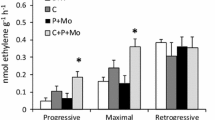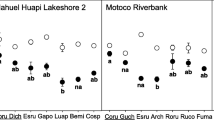Abstract
Relationships involving the transfer of nitrogen (N) among Salix reinii (willow), Larix kaempferi (larch), and mycorrhizal fungi were investigated in a ridge and hillslope on the volcano Mount Koma in northern Japan using a two-pool fungal model. This model estimated N transfer among the examined taxa by measuring changes in the stable isotope ratio of N (δ15N). Although N content in tephra was low at both sites, it was higher on the ridge than on the hillslope, and higher in the willow patch than on bare ground or in the larch understory. The non-mycorrhizal sedge (Carex oxyandra) exhibited non-significant differences between the two sites regarding δ15N for N obtained from tephra. Larches developed a relationship with larch-specific Suillus mycorrhizal fungal species in the roots, and had a lower foliar δ15N on the hillslope than on the ridge. The larch δ15N increased during the growing season, while the willow δ15N remained stable. The dependence of larch on mycorrhizal fungi for N uptake was 3–5 % on the ridge and 56–76 % on the hillslope in autumn. Therefore, larches exhibited a flexible symbiotic relationship with mycorrhizal fungi for obtaining N. Over 45 % of the N taken up by willow plants was obtained from mycorrhizal fungi at both sites. In conclusion, willow plants promoted N deposition in tephra through the litter supply, and formed a stable relationship with mycorrhizal fungi. This enabled successful revegetation with larch plants, which exhibited flexibility in terms of N uptake (i.e., dependent on mycorrhizae or from tephra).




Similar content being viewed by others
References
Akasaka M, Tsuyuzaki S (2009) Comparisons of recruitment, survival, and growth in invasive and native saplings on a volcano. Plant Ecol 202:235–245. doi:10.1007/s11258-008-9464-4
Cairney JWG (2000) Evolution of mycorrhiza systems. Naturwissenschaften 87:467–475. doi:10.1007/s001140050762
Callaway RM (2007) Direct mechanisms for facilitation. In: Callaway RM (ed) Positive Interactions and Interdependence in plant communities. Springer. Dordrecht, The Netherlands: 56–83. doi:10.1007/978-1-4020-6224-7_2
Coplen TB (2011) Guidelines and recommended terms for expression of stable-isotope-ratio and gas-ratio measurement results. Rapid Commun Mass Spectrom 25:2538–2560. doi:10.1002/rcm.5129
Deckmyn G, Meyer A, Smits MM, Ekblad A, Grebenc T, Komarov A, Kraigher H (2014) Simulating ectomycorrhizal fungi and their role in carbon and nitrogen cycling in forest ecosystems. Can J For Res 44:535–553. doi:10.1139/cjfr-2013-0496
Duddridge JA (1986) The development and ultrastructure of ectomycorrhizas. New Phytol 103:457–464. doi:10.1111/j.1469-8137.1986.tb02883.x
Finlay RD (1989) Functional aspects of incompatible ectomycorrhizal associations. Agric Ecosyst Environ 28:127–131. doi:10.1016/0167-8809(90)90027-B
Finlay RD (2008) Ecological aspects of mycorrhizal symbiosis: with special emphasis on the functional diversity of interactions involving the extraradical mycelium. J Exp Bot 59:1115–1126. doi:10.1093/jxb/ern059
Haruki M, Tsuyuzaki S (2001) Woody plant establishment during the early stages of volcanic succession on Mount Usu, northern Japan. Ecol Res 16:451–457. doi:10.1046/j.1440-1703.2001.00407.x
Hasselquist NJ, Högberg P (2014) Dosage and duration effects of nitrogen additions on ectomycorrhizal sporocarp production and functioning: an example from two N-limited boreal forests. Ecol Evol 4:3015–3026. doi:10.1002/ece3.1145
Hobbie EA, Agerer R (2010) Nitrogen isotopes in ectomycorrhizal sporocarps correspond to belowground exploration types. Plant Soil 327:71–83. doi:10.1007/s11104-009-0032-z
Hobbie JE, Hobbie EA (2006) 15N in symbiotic fungi and plants estimates nitrogen and carbon flux rates in arctic tundra. Ecology 87:816–822. doi:10.1890/0012-9658(2006)87[816:NISFAP]2.0.CO;2
Hobbie EA, Högberg P (2012) Nitrogen isotopes link mycorrhizal fungi and plants to nitrogen dynamics. New Phytol 196:367–382. doi:10.1111/j.1469-8137.2012.04300.x
Hobbie EA, Horton TR (2007) Evidence that saprotrophic fungi mobilise carbon and mycorrhizal fungi mobilise nitrogen during litter decomposition. New Phytol 173:447–449. doi:10.1111/j.1469-8137.2007.01984.x
Hobbie EA, Ouimette AP (2009) Controls of nitrogen isotope patterns in soil profiles. Biogeochemistry 95:355–371. doi:10.1007/s10533-009-9328-6
Hobbie EA, Macko SA, Williams M (2000) Correlations between foliar δ15N and nitrogen concentrations may indicate plant-mycorrhizal interactions. Oecologia 122:273–283. doi:10.1007/PL00008856
Kayama M, Qu L, Koike T (2015) Elements and ectomycorrhizal symbiosis affecting the growth of Japanese larch seedlings regenerated on slopes of an active volcano in northern Japan. Trees 29:1567–1579. doi:10.1007/s00468-015-1238-8
Kondo T, Tsuyuzaki S (1999) Natural regeneration patterns of the introduced larch, Larix kaempferi (Pinaceae), on the volcano Mount Koma, northern Japan. Divers Distrib 5:223–233. doi:10.1046/j.1472-4642.1999.00056.x
Leake J, Johnson D, Donnelly D, Muckle G, Boddy L, Read D (2004) Networks of power and influence: the role of mycorrhizal mycelium in controlling plant communities and agroecosystem functioning. Can J Bot 82:1016–1045. doi:10.1139/b04-060
Li J, Zhao C, Zhu H, Li Y, Wang F (2007) Effect of plant species on shrub fertile island at an oasis-desert ecotone in the South Junggar Basin, China. J Arid Environ 71:350–361. doi:10.1016/j.jaridenv.2007.03.015
Matson P (1990) Plant-soil interactions in primary succession at Hawaii Volcanoes National Park. Oecologia 85:241–246. doi:10.1007/BF00319408
Michelsen A, Quarmby C, Sleep D, Jonasson S (1998) Vascular plant 15N natural abundance in heath and forest tundra ecosystems is closely correlated with presence and type of mycorrhizal fungi in roots. Oecologia 115:406–418. doi:10.1007/s004420050535
Morishita T, Hatano R, Nagata O, Sakai K, Koide T, Nakahara O (2004) Effect of nitrogen deposition on CH4 uptake in forest soils in Hokkaido, Japan. Soil Sci Plant Nutr 50:1187–1194. doi:10.1080/00380768.2004.10408593
Nara K (2006) Pioneer dwarf willow may facilitate tree succession by providing late colonizers with compatible ectomycorrhizal fungi in a primary successional volcanic desert. New Phytol 171:187–198. doi:10.1111/j.1469-8137.2006.01744.x
Nara K, Hogetsu T (2004) Ectomycorrhizal fungi on established shrubs facilitate subsequent seedling establishment of successional plant species. Ecology 85:1700–1707. doi:10.1890/03-0373
Nave LE, Nadelhoffer KJ, Le Moine JM, van Diepen LT, Cooch JK, Van Dyke NJ (2013) Nitrogen uptake by trees and mycorrhizal fungi in a successional northern temperate forest: insights from multiple isotopic methods. Ecosystems 16:590–603. doi:10.1007/s10021-012-9632-1
Qu L, Quoreshi AM, Iwase K, Tamai Y, Funada R, Koike T (2003) In vitro ectomycorrhiza formation on two larch species of seedlings with six different fungal species. Eur J For Res 6:65–73. http://hdl.handle.net/2115/22162
R Core Team (2014) R: A language and environment for statistical computing. R Foundation for Statistical Computing, Vienna, Austria. http://www.R-project.org/. Accessed 28 May 2015
Read DJ (1991) Mycorrhizas in ecosystems. Experientia 47:376–391. doi:10.1007/BF01972080
Read DJ, Perez-Moreno J (2003) Mycorrhizas and nutrient cycling in ecosystems–a journey towards relevance? New Phytol 157:475–492. doi:10.1046/j.1469-8137.2003.00704.x
Sakai Y, Takahashi M, Tanaka N (2007) Root biomass and distribution of a Picea-Abies stand and a Larix-Betula stand in pumiceous Entisols in Japan. J For Res 12:120–125. doi:10.1007/s10310-006-0270-3
Schimel JP, Bennett J (2004) Nitrogen mineralization: challenges of a changing paradigm. Ecology 85:591–602. doi:10.1890/03-8002
Schofield JA, Hagerman AE, Harold A (1998) Loss of tannins and other phenolics from willow leaf litter. J Chem Ecol 24:1409–1421. doi:10.1023/A:1021287018787
Shibata H, Urakawa R, Toda H, Inagaki Y, Tateno R, Koba K, Yamasaki A et al (2011) Changes in nitrogen transformation in forest soil representing the climate gradient of the Japanese archipelago. J For Res 16:374–385. doi:10.1007/s10310-011-0288-z
Simard SW, Jones MD, Durall DM (2002) Carbon and nutrient fluxes within and between mycorrhizal plants. In: van der Heijden MGA, Sanders IR (eds) Mycorrhizal ecology. Springer, Berlin, Germany, pp 33–74. doi:10.1007/978-3-540-38364-2_2
Taylor AF, Högbom L, Högberg M, Lyon AJ, Näsholm T, Högberg P (1997) Natural 15N abundance in fruit bodies of ectomycorrhizal fungi from boreal forests. New Phytol 136:713–720. doi:10.1046/j.1469-8137.1997.00788.x
Titus JH, Tsuyuzaki S (2002) Arbuscular mycorrhizal distribution in relation to microsites on recent volcanic substrates of Mt. Koma, Hokkaido, Japan. Mycorrhiza 12:271–275. doi:10.1007/s00572-002-0182-9
Tsuyuzaki S, Hase A, Niinuma H (2005) Distribution of different mycorrhizal classes on Mount Koma, northern Japan. Mycorrhiza 15:93–100. doi:10.1007/s00572-004-0304-7
Tsuyuzaki S, Matsuda M, Akasaka M (2012) Effect of a deciduous shrub on microclimate along an elevation gradient, Mount Koma, northern Japan. Clim Res 51:1–10. doi:10.3354/cr01047
Uesaka S, Tsuyuzaki S (2004) Differential establishment and survival of species in deciduous and evergreen shrub patches and on bare ground, Mt. Koma, Hokkaido,Japan. Plant Ecol 175:165–177. doi:10.1007/s11258-005-4839-2
Urakawa R, Shibata H, Kuroiwa M et al (2014) Effects of freeze–thaw cycles resulting from winter climate change on soil nitrogen cycling in ten temperate forest ecosystems throughout the Japanese archipelago. Soil Biol Biochem 74:82–94. doi:10.1016/j.soilbio.2014.02.022
Usami H, Tamai Y, Yajima T, Miyamoto T (2007) Regeneration and ectomycorrhiza formation of Larix kaempferi at Mt. Komagatake, Hokkaido. Proc Jpn Forest Soc Cong 118:C31 (in Japanese)
Van Auken OW, Gese EM, Connors K (1985) Fertilization response of early and late successional species: Acacia smallii and Celtis laevigata. Bot Gaz 146:564–569
Wallander H, Nylund JE (1991) Effects of excess nitrogen on carbohydrate concentration and mycorrhizal development of Pinus sylvestris L. seedlings. New Phytol 119:405–411. doi:10.1111/j.1469-8137.1991.tb00040.x
Wallander H, Nylund JE (1992) Effects of excess nitrogen and phosphorus starvation on the extramatrical mycelium of ectomycorrhizas of Pinus sylvestris L. New Phytol 120:495–503. doi:10.1111/j.1469-8137.1992.tb01798.x
Yang K, Shi W, Zhu JJ (2013) The impact of secondary forests conversion into larch plantations on soil chemical and microbiological properties. Plant Soil 368:535–546. doi:10.1007/s11104-012-1535-6
Yoshioka K (1966) Development and recovery of vegetation since the 1929 eruption of Mt. Komagatake. Hokkaido. Ecol Rev 16:271–292
Acknowledgments
We thank Dr. T. Igarashi for advice regarding the mycorrhizae and Y. Hoshino for her help with analyses. The field work completed in this study was conducted with permission from the Mori Town Office, Japanese Forest Management Office (Oshima Branch) and the Usujiri Fisheries Station of Hokkaido University.
Author information
Authors and Affiliations
Corresponding author
Ethics declarations
Conflict of interest
There is no conflict of interest regarding the publication of this paper.
About this article
Cite this article
Kwon, T., Tsuyuzaki, S. Differences in nitrogen redistribution between early and late plant colonizers through ectomycorrhizal fungi on the volcano Mount Koma. Ecol Res 31, 557–567 (2016). https://doi.org/10.1007/s11284-016-1364-9
Received:
Accepted:
Published:
Issue Date:
DOI: https://doi.org/10.1007/s11284-016-1364-9




